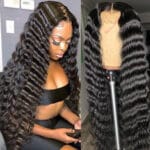When it comes to wigs, weaves and hair extensions, human hair is a popular choice. Not only does it allow you to style your hair enhancements like you would your real hair, quality human hair can also last years with correct care. But, where does the human hair for wigs, weaves and extensions really come from? Let’s take a look.
Where Is The Most Popular Human Hair From?
So where do wigs come from? As simple as it may sound, it’s a tricky question. Lack of regulation and transparency within the global hair industry coupled with fragmented supply chains means it can be difficult to neatly draw a straight line through the lifecycle of human hair extensions. However, it’s not impossible.
Whilst those less familiar with the market have often assumed that all extensions are made from Caucasian hair originating in Europe, it’s, in fact, Eastern countries where hair collection centres are often located. Hair from countries including India, Russia, Cambodia, Vietnam and Mongolia is especially popular and amongst the most expensive owing to its virgin status; meaning that the hair has never been chemically treated prior to being made into extensions.
Are Human Hair Extension Made From Hair From The Same Person?
This depends on where and how your hair is sourced. Libeca, a company that prides itself on offering ethically sourced hair sells only bundles that come from a single donor.
However, for companies with less transparency and less regard for the quality and sourcing of their hair this won’t always be the case. For hair that is sourced from salon floor waste or from plug holes for example, the probability that all the hair stems from a single donor is near impossible owing to the nature in which the hair was collected.
Are All Human Hair Extensions High Quality?
Virgin, remy hair (hair that has never been chemically processed with cuticles that align in the same direction) is largely considered the highest quality of human hair currently available on the market. This helps buyers and sellers gauge the value and quality of human hair extensions.
Hair grading is also used by sellers across the world to help determine the quality of hair extensions bought and sold. Unfortunately, as the industry is largely unregulated, so is the grading system. This means that a seller can advertise their hair extensions as 10A quality (the highest quality) regardless of whether it actually meets that standard, meaning people have been and continue to be scammed, especially online.
Additionally, human hair can be sourced from a variety of locations and donors. While we’d like to think the new extensions we bought came from a credible source and are of single-donor origins, the grim reality is that your hair may have been sourced illegally from salon floors, drains or even corpses. The hair might not even be 100% human at all as sellers often ‘cut’ hair by mixing human hair with animal or synthetic hair and fibres to pass off as 100% human for more profit.
Is Human Hair Ethically Sourced?
Some is, and some isn’t. Whether your hair has been ethically sourced (meaning it came from willing donors who were paid a fair price) will depend on whom you’re buying it from. Unfortunately, a lack of transparency in the global hair industry means that it can be difficult to ascertain if your human hair extensions are ethically sourced.
Some manufacturers and distributors like Remy NY and Luxy Hair are open about their supply chains making it easier to know where your extensions are coming from and if they were ethically sourced.
But the sad reality is that a large chunk of human hair sold is not ethically sourced–how large that chunk is is also hard to determine, again owing to the fact that the industry is still largely unregulated.
Are There Alternatives To Human Hair For Wigs And Extensions?
Human hair isn’t for everyone. Some people may want to enjoy the fun and transformative powers of hair extensions without having to turn to human hair for their wigs and extensions.
Synthetic hair is currently experiencing increased popularity thanks to an improvement in quality. While synthetic hair has in the past been widely associated with being cheap, low in quality and only good for garish costume wigs, this perception is slowly changing.
Companies like Outre and Sensational are offering high-quality synthetic wigs that can even rival human hair in some aspects including look and feel. Some synthetic hair can now even be heat styled and coupled with their more accessible price points, it makes synthetic hair a more desirable option for many people.
In particular, for someone who only uses hair extensions or wigs every so often, a synthetic option may be more suitable for them as opposed to someone who wears hair extensions regularly and therefore is looking for something that will last for years, prompting them to choose high-quality human hair instead.
Unfortunately, synthetic hair extensions are often made from plastic and are therefore not biodegradable as well as arguably more harmful to our environment. This makes them less attractive to people who are conscious of making more sustainable choices. But how can you make hair extensions and wigs more sustainable? Through alternative materials.
Companies like Raw Society are hoping to make the hair extensions business more sustainable by using alternative materials to create hair extensions like clip-ins and wigs. While Raw Society currently uses banana fibres for their extensions, they’re now working on new material using plant waste from India.
How Do I Make Sure I’m Buying Quality Human Hair Online?
With the hair industry shrouded in so much mystery, it can be difficult to save yourself from getting scammed and knowing if your human hair is really worth the money. Here are some tips you can keep in mind when buying human hair online:
- Do your research – There are a lot of options available online when it comes to buying human hair online. While this can be a blessing and a curse, start off by dedicating time to research what you’re looking for.
- Read reviews – Once you’ve found a seller whose extensions you like the look of, make sure you read their reviews on their site and also search for reviews of the brand on Google and YouTube.
- Ask questions – It never hurts to get in touch with the seller directly. Ask them a lot of questions; including the source of the hair, how it was (or wasn’t processed) etc. Companies with nothing to hide will often take the time to answer your queries but if they vehemently refuse, it could be a sign that the hair being sold isn’t as advertised. In that case, it may be best to look for an alternative seller.





